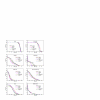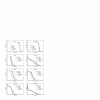On the performances of different IMRT Treatment Planning Systems for selected paediatric cases
- PMID: 17302972
- PMCID: PMC1803794
- DOI: 10.1186/1748-717X-2-7
On the performances of different IMRT Treatment Planning Systems for selected paediatric cases
Abstract
Background: To evaluate the performance of seven different TPS (Treatment Planning Systems: Corvus, Eclipse, Hyperion, KonRad, Oncentra Masterplan, Pinnacle and PrecisePLAN) when intensity modulated (IMRT) plans are designed for paediatric tumours.
Methods: Datasets (CT images and volumes of interest) of four patients were used to design IMRT plans. The tumour types were: one extraosseous, intrathoracic Ewing Sarcoma; one mediastinal Rhabdomyosarcoma; one metastatic Rhabdomyosarcoma of the anus; one Wilm's tumour of the left kidney with multiple liver metastases. Prescribed doses ranged from 18 to 54.4 Gy. To minimise variability, the same beam geometry and clinical goals were imposed on all systems for every patient. Results were analysed in terms of dose distributions and dose volume histograms.
Results: For all patients, IMRT plans lead to acceptable treatments in terms of conformal avoidance since most of the dose objectives for Organs At Risk (OARs) were met, and the Conformity Index (averaged over all TPS and patients) ranged from 1.14 to 1.58 on primary target volumes and from 1.07 to 1.37 on boost volumes. The healthy tissue involvement was measured in terms of several parameters, and the average mean dose ranged from 4.6 to 13.7 Gy. A global scoring method was developed to evaluate plans according to their degree of success in meeting dose objectives (lower scores are better than higher ones). For OARs the range of scores was between 0.75 +/- 0.15 (Eclipse) to 0.92 +/- 0.18 (Pinnacle(3) with physical optimisation). For target volumes, the score ranged from 0.05 +/- 0.05 (Pinnacle(3) with physical optimisation) to 0.16 +/- 0.07 (Corvus).
Conclusion: A set of complex paediatric cases presented a variety of individual treatment planning challenges. Despite the large spread of results, inverse planning systems offer promising results for IMRT delivery, hence widening the treatment strategies for this very sensitive class of patients.
Figures






Similar articles
-
Importance of protocol target definition on the ability to spare normal tissue: an IMRT and 3D-CRT planning comparison for intraorbital tumors.Int J Radiat Oncol Biol Phys. 2005 Aug 1;62(5):1540-8. doi: 10.1016/j.ijrobp.2005.04.013. Int J Radiat Oncol Biol Phys. 2005. PMID: 16029816
-
Treatment plan comparison between helical tomotherapy and MLC-based IMRT using radiobiological measures.Phys Med Biol. 2007 Jul 7;52(13):3817-36. doi: 10.1088/0031-9155/52/13/011. Epub 2007 May 31. Phys Med Biol. 2007. PMID: 17664579
-
Assessment of volume segmentation in radiotherapy of adolescents; a treatment planning study by the Swedish Workgroup for Paediatric Radiotherapy.Acta Oncol. 2014 Jan;53(1):126-33. doi: 10.3109/0284186X.2013.782104. Epub 2013 Apr 12. Acta Oncol. 2014. PMID: 23577745
-
Pediatric radiation oncology.Invest Radiol. 1986 May;21(5):429-36. doi: 10.1097/00004424-198605000-00016. Invest Radiol. 1986. PMID: 3011704 Review. No abstract available.
-
Evolving Radiotherapy Techniques in Paediatric Oncology.Clin Oncol (R Coll Radiol). 2019 Mar;31(3):142-150. doi: 10.1016/j.clon.2018.12.005. Epub 2019 Jan 11. Clin Oncol (R Coll Radiol). 2019. PMID: 30639254 Review.
Cited by
-
A comparison of the dose distributions from three proton treatment planning systems in the planning of meningioma patients with single-field uniform dose pencil beam scanning.J Appl Clin Med Phys. 2015 Jan 8;16(1):4996. doi: 10.1120/jacmp.v16i1.4996. J Appl Clin Med Phys. 2015. PMID: 25679158 Free PMC article.
-
Feasibility and sensitivity study of helical tomotherapy for dose painting plans.Acta Oncol. 2010 Oct;49(7):991-6. doi: 10.3109/0284186X.2010.500302. Acta Oncol. 2010. PMID: 20831487 Free PMC article.
-
Helical tomotherapy in the treatment of pediatric malignancies: a preliminary report of feasibility and acute toxicity.Radiat Oncol. 2011 Aug 26;6:102. doi: 10.1186/1748-717X-6-102. Radiat Oncol. 2011. PMID: 21871078 Free PMC article.
-
On the performances of Intensity Modulated Protons, RapidArc and Helical Tomotherapy for selected paediatric cases.Radiat Oncol. 2009 Jan 14;4:2. doi: 10.1186/1748-717X-4-2. Radiat Oncol. 2009. PMID: 19144155 Free PMC article.
-
Superiorization of projection algorithms for linearly constrained inverse radiotherapy treatment planning.Front Oncol. 2023 Oct 26;13:1238824. doi: 10.3389/fonc.2023.1238824. eCollection 2023. Front Oncol. 2023. PMID: 38033492 Free PMC article.
References
-
- Taylor R. Cancer in childern: radiotherapeutic approaches. Br Med Bull. 1996;52:873–886. - PubMed
-
- Parliament MB, Scrimger RA, Anderson SG, Kurien EC, Thompson HK, Field GC, Hanson J. Preservation of oral health-related quality of life and salivary flow rates after inverse-planned intensity- modulated radiotherapy (IMRT) for head-and-neck cancer. Int J Radiat Oncol Biol Phys. 2004;58:663–673. doi: 10.1016/S0360-3016(03)01571-2. - DOI - PubMed
MeSH terms
LinkOut - more resources
Full Text Sources
Miscellaneous

